Charida is a small village in Baghmundi block that comes under the Jhalda subdivision in the Purulia district in West Bengal. This small village’s fame is for Chau mask makers. Chau mask is an essential part of the Purulia Chau Dance. That is why Charida is also known as “Mukhosh Gram” or Chau Mask Village.
Table of Contents
History of Chau-mask Making
Although the Chau mask is an integral part of the Purulia Chau Dance, it was not there initially. It is not clear from when Chau Dance was practised by tribal communities in the eastern part of Chotonagpur Plateau. Chau Dance got local kings’ patronage from the early nineteenth century that helped more people recognise it. In the three subgenres of Chau Dance, Mayurbhanj Chau does not use a mask, whereas a mask is a part of Serakella Chau and is used extensively in Purulia Chau Dance.
Though Seraikella and Purulia Chau dancers both use masks, the masks used for Purulia Chau are quite distinct from Seraikella Chau’s. Purulia Chau masks are of larger sizes and jazzy decorations, which make them heavier.
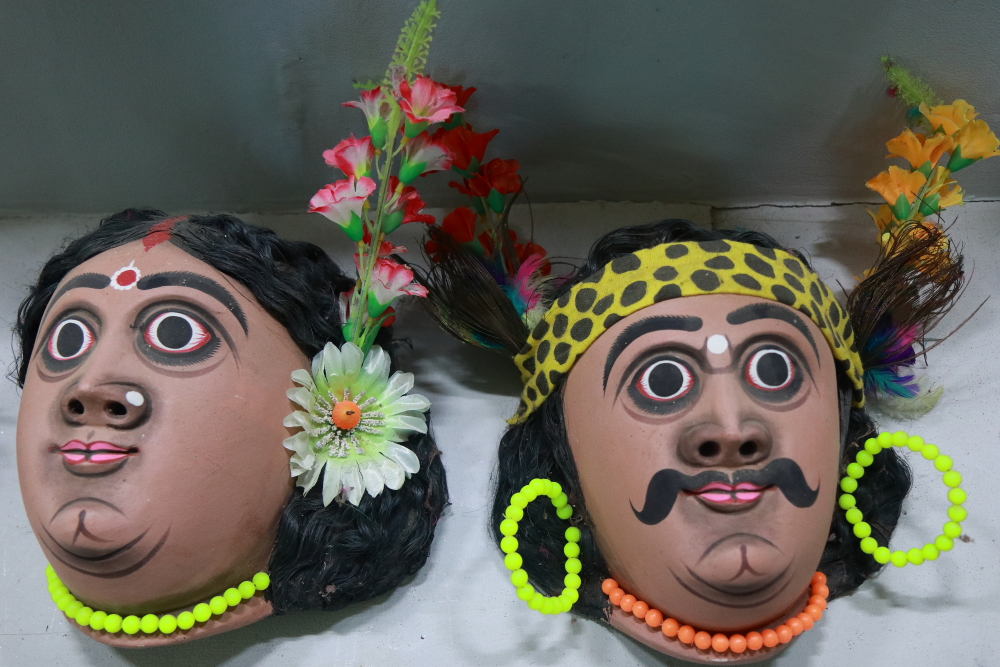
The Purulia Chhau mask is registered in the List of Geographical Indications in India.
In the initial days, Chau was just a part of many folk dances performed by tribes for invocation of Lord Shiva for endowing them with rain after the onset of summer.
It was initially performed as an imitation of the animals with the rhythm of local instruments. The performers used to cover their faces with ash. Then gradually, they started to use colours to paint the faces. And when Chau Dance became popular in the community, dancers started to form groups and incorporated stories from the Epic Hindu literature like Ramayana and Mahabharata, and Puranas to make the performances more interesting. And the use of masks started to help the audience to communicate with the characters that are being portrayed.
The Purulia Chau masks are made exclusively in the small village of Charida. The mask-making tradition started in Charida about 150 years back during the reign of King Madan Mohan Singh Deo of Baghmundi when he invited a few Sutradhar families to Charida and gave them lands to settle. The uses of the Purulia Chau mask was popularized by veteran Chau dancers like Gambhir Singh Mura and Nepal Mahato, both of whom were Padmasree awardees.
The Artisans of Charida Village
Charida can be rightly termed as an ‘artisans village’ as nearly 500 families earn their livelihood by making masks.
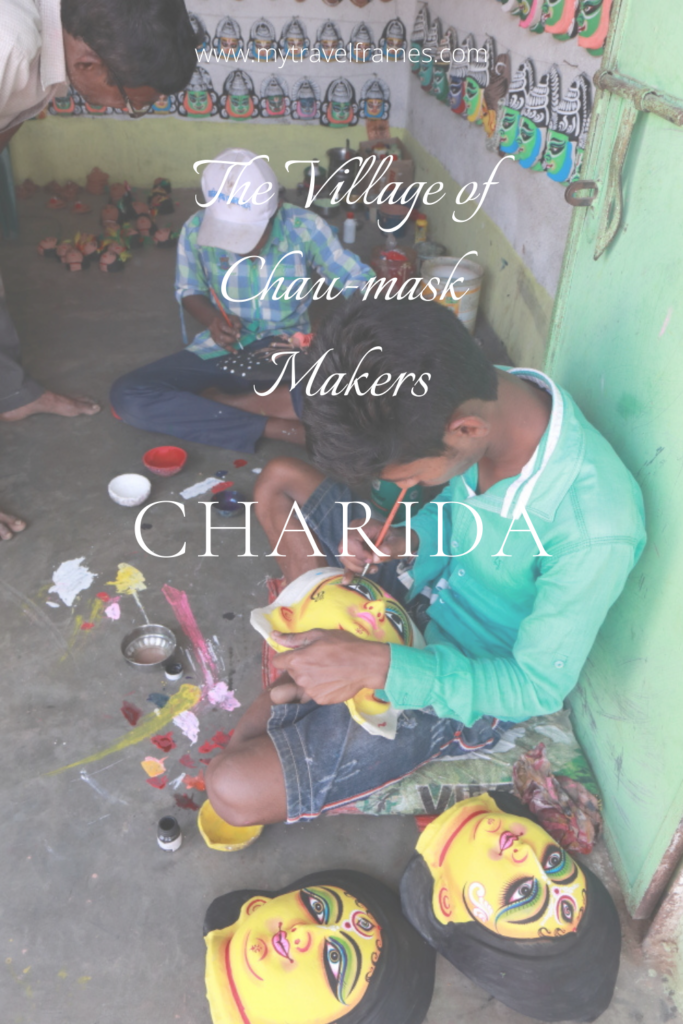
Pin this image to save the link and read the post later!!
In the old days, mask makers were mostly from one single community called Sutradhars. More than a century back, when local king Madan Mohan Singh Deo invited 20 Sutradhar families from Burdwan and gave them lands in Charida, they were asked to build the new idols of deities in the palace. These families, settled in Charida, subsequently started making masks for Chau dancers as well, in addition to making deities of the royal family.
For a long time, only members from the Sutradhar community used to make these masks. But as Chau Dance got global recognition and tourists started pouring to Charida village, the local economy started growing based on Chau mask-making. As a result, this caste-based exclusiveness started fading, and members from other communities started making masks.
Process of Chau-mask making
Chau mask-making is an elaborate process and takes several days.
First, the clay is collected from the banks of a rivulet flowing beside Charida village. Then the clay is shaped into masks by the master craftsmen. These clay masks work as frames for the rest of the process.
Now, ash is poured over the frames before the papers are stuck with adhesive. Then, the newspaper shreds, 8-15 layers thick, are pasted on the clay masks before they are left out to dry under the sun for a day.
Next, a thin coating of bele mati (soil with high sand content) is applied to each mask. A cloth smeared with clay placed over the coating, and a wooden carving tool is used to polish the mask and create facial features like eyes, nose and mouth.

After it’s dried, the cloth is removed carefully, and the mask is plastered with khori mati — soil with high calcium content. Colours are then applied, and the masks are decorated with beads, ribbons, artificial flowers and leaves.
Types of Purulia Chau Masks
Chau masks are of immense importance for Chau Dance. These large colourful masks are an identity of Purulia Chau. The use of a mask is important for both the artist and the audience. While it acts as a metaphor for the audience, artists can easily get into the character once they place the masks in front of the faces.
Several kinds of masks are made by the artisans depending on the themes and characters that are portrayed. They can be broadly categorized into masks for Gods and Goddesses, masks for demons and ghosts, masks for human characters, and masks for animal characters.
I saw another distinct list, categorising different kinds of masks made by the artisans, displayed inside the Folk Art Centre run by the co-operative of mask-makers in Charida village, which I have mentioned below.
- Babu Masks – for Gods (Shiva, Narayana, Ganesha, Kartik and Krishna)
- Bir masks – for demons (Ravana, Mahishasur, Tarakasur, Sumbha, Nisumbha)
- Nari masks – for women characters particularly Goddesses (Durga, Laxmi, Saraswati, Sita)
- Bhoot masks – for ghosts and spirits
- Animal masks – for tiger, lion, buffalo and apes from the Ramayana (Bali and Sugrib)
- Bird masks – for peacock, swan and Jatayu from epic Ramayana
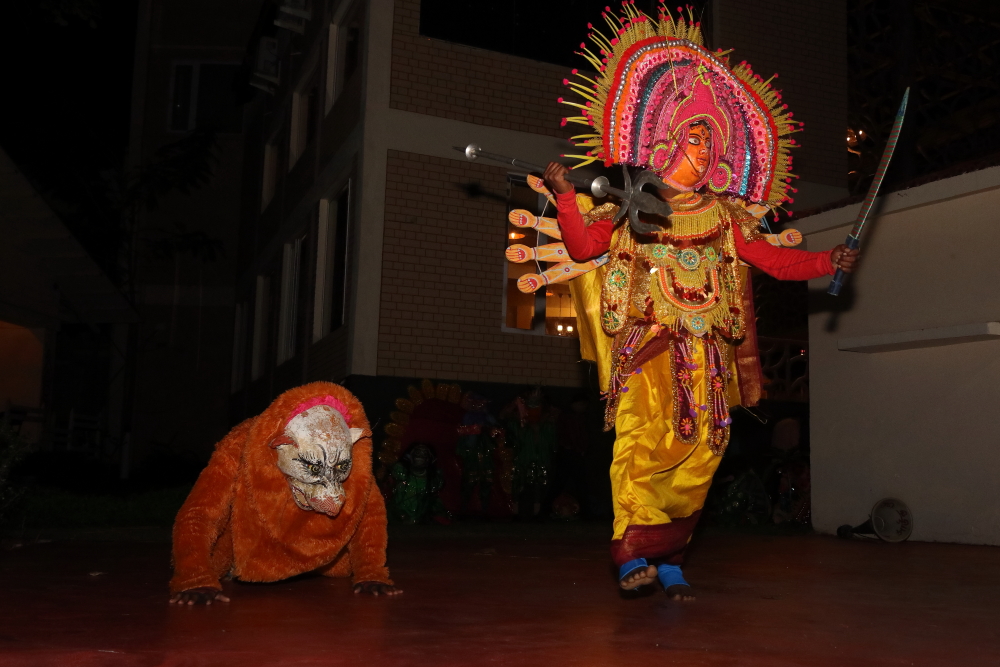
Chau Mask-making Workshops in Charida Village
Once you reach the village, you will see that mask shops, also used as workshops by the artists, on both sides of the road. Almost every residential house in the village has a workshop room inside.
Tourists can see the masks lying open by the road’s side in the different stages of preparation. Each mask usually takes 5-7 days to prepare. You will notice family members busy colouring and decorating the masks in these shops. The large ones used for Chau Dance are mostly made during winter, the season before spring when the Chaitra Parab is celebrated in Purulia. These large masks are usually ordered beforehand by the dance groups and customised accordingly by the mask artists.
Apart from the larger ones, you will see many small to moderate-sized masks hanging from the wall or lying over the mat on the floor inside the workshops. These are bought as souvenirs by tourists to decorate their drawing-rooms.
Folk Art Centre in Charida Village
There is a Folk Art Centre on the ground floor of a two-storied building situated a few meters inside of the main road where you can see a display of various kinds of Chau masks. Some of them are really exquisite in their artistic quality. You can also learn more about the history of Chau masks, the process of making them, the materials used to make them and the categorical classification of masks that are made here. This Art Centre is run by a local co-operative of mask makers in Charida village.
Entry Fee: ₹10 per person
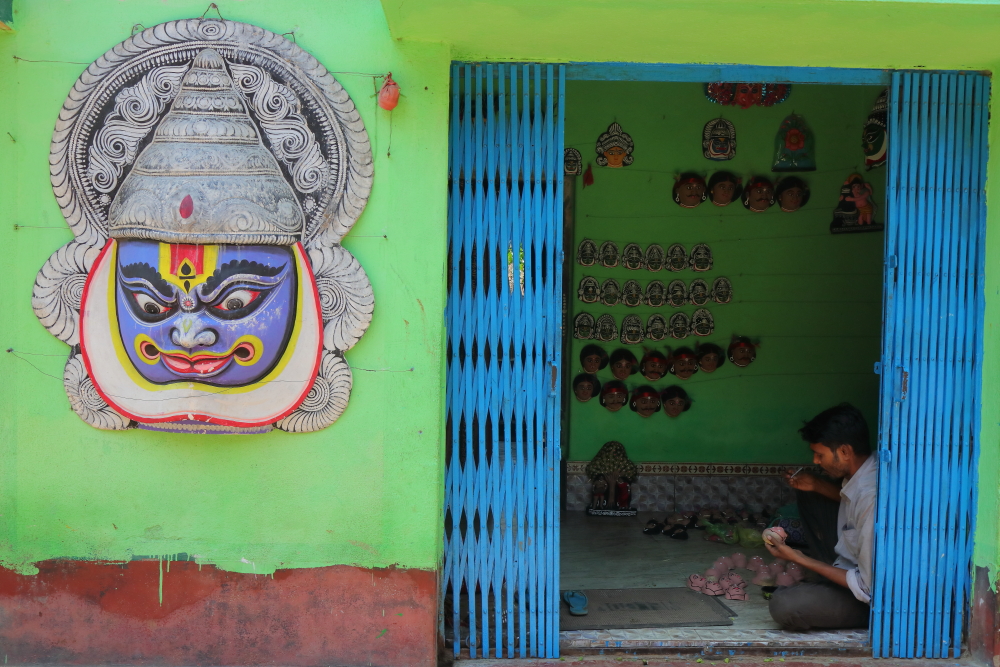
How to Reach Charida Village
You can go to Charida by road from Kolkata, which takes around 7 hours. The distance between Kolkata and Charida village is 340 kilometres.
The nearest railway station is Barabhum which is 27 kilometres away. Purulia station to Charida village distance is 67 kilometres whereas the village is at 38 kilometres from Muri Junction. Ajodhya hilltop is 16 kilometres away from Charida village.
Google Map
When to Visit
Except for summer, you can go to Charida round the year. In winter (November to February) and spring (March-April), many tourists visit this village during their trip to Purulia and nearby places.
For the last few years, Charida hosts the yearly Chhau Mask Festival in the cold month of December. Charida’s famous craftsmen have travelled as far as Japan and France to showcase their works.
What to Buy
You can buy different kinds of Chau masks available in different sizes. The price varies from ₹100 to ₹5000, depending on the size and artistic work. The popular masks are the dual masks of a tribal couple which is actually Kirat-Kirateeni (the tribal forms of Shiva-Shakti) from the story of Kiratarjuniya and the mask of Goddess Durga (from the story of Mahishasuramardini).
You can also buy Chau masks online.
Where to Stay
There are no accommodations available in Charida. You can stay in Baghmundi, which is 5 kilometres away from Charida. Else, you can stay at other popular tourist spots like Khairabera, Ayodhya Hills, Purulia and visit Charida on a half-day trip.
- Baghmundi – Aranyak Lodge, Chowburu Homestay
- Khairabera – Khairabera Eco Adventure Resort
- Ayodhya hilltop – CADC Lodges – Niharika/Malabika, Kushal Palli Resort
- Purulia town – Youth Hostel, Hotel Akash Sarovar
Nearby Attractions
There are many attractions near Charida village that you can visit during your trip.
- Khairabera Dam and Chamtaburu Hill
- Pakhipahar and Pardi Dam
- Ayodhya Pahar
- Deulghata Temples

Book your trip: Resources
- Flight
Use Skyscanner or Google Flights to book your flight.
- Accommodation
Tripadvisor and Agoda are perfect for booking your hotel. If you want to stay in a hostel, then Hostelworld would greatly help you find one at your convenience.
- Travel Insurance
World Nomads is perfect for travel insurance. You can get comprehensive protection from them. Let them take care of unexpected situations while you concentrate on your trip.
- Package Tour and Activities
You can book a package tour from G-Adventures and Viator. They are a reputed company arranging small group tours and customising them per your requirements. You can also use Get Your Guide to book your private transport, city tours, heritage walks, food walks and other experiences like a cooking lesson or a Yoga session.
Disclosure: Some of the links below are affiliate links. You will be directed to another third-party website when you click those links. If you purchase anything via those links, I will earn a referral bonus without any extra cost to you.

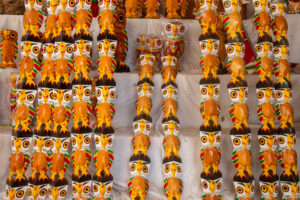
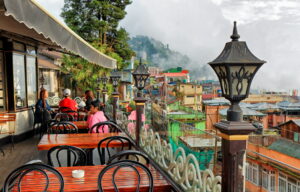
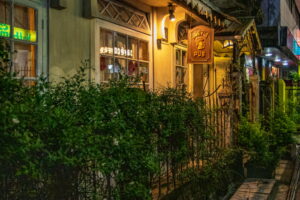
Pingback: Trip to Ayodhya Hills in Purulia | A Perfect Weekend Destination from Kolkata
Pingback: Purulia Chau Dance | A Cultural Heritage From West Bengal - My Travel Frames